Comprehensive Financial Analysis: Benedict Co. Ratio Evaluation
VerifiedAdded on 2023/04/21
|9
|1543
|108
Report
AI Summary
This report provides a financial analysis of Benedict Co. using various financial ratios to evaluate the company's financial position and performance. The analysis includes liquidity ratios (Current Ratio and Quick Ratio) and activity ratios (Trade Receivable Days, Trade Payable Days, and Inventory Turnover Ratio) to assess the company's ability to meet its current obligations and manage its operations effectively. The report also considers aspects of Tesco Plc., including its stakeholders and corporate governance, for comparative analysis. The findings indicate a decline in Benedict Co.'s liquidity and operational efficiency over the trend period. Desklib offers a platform for students to access similar solved assignments and study resources.
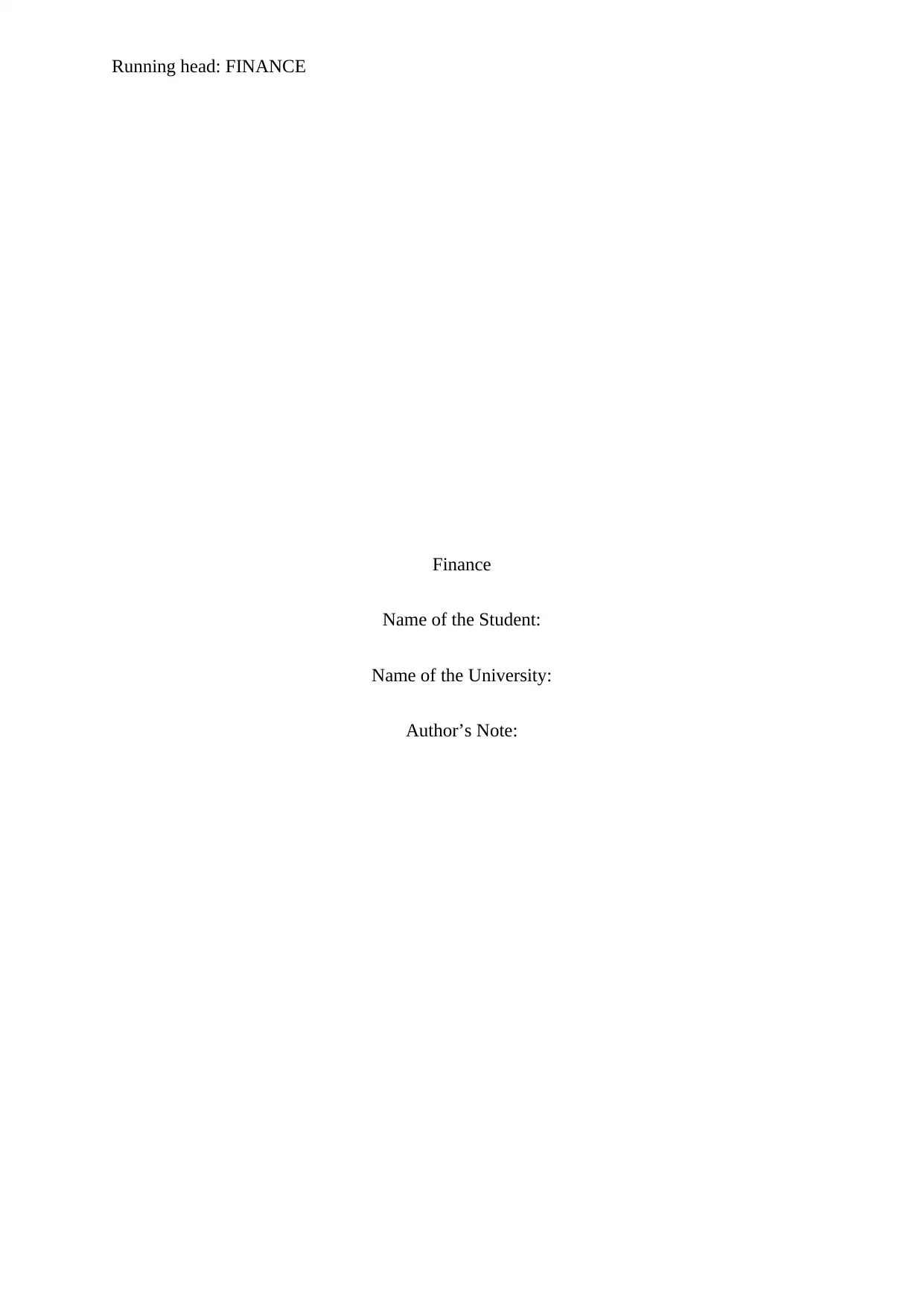
Running head: FINANCE
Finance
Name of the Student:
Name of the University:
Author’s Note:
Finance
Name of the Student:
Name of the University:
Author’s Note:
Paraphrase This Document
Need a fresh take? Get an instant paraphrase of this document with our AI Paraphraser
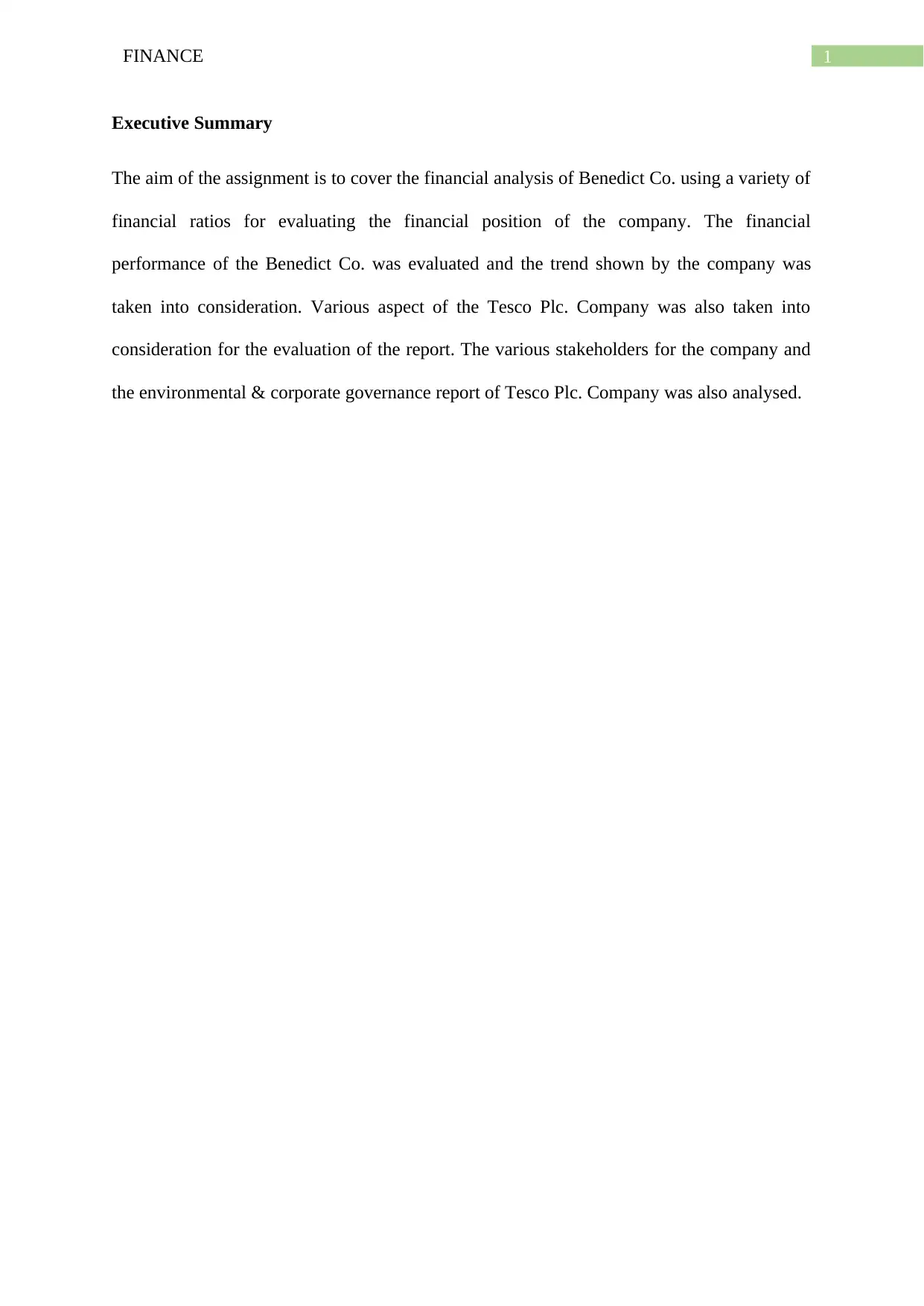
1FINANCE
Executive Summary
The aim of the assignment is to cover the financial analysis of Benedict Co. using a variety of
financial ratios for evaluating the financial position of the company. The financial
performance of the Benedict Co. was evaluated and the trend shown by the company was
taken into consideration. Various aspect of the Tesco Plc. Company was also taken into
consideration for the evaluation of the report. The various stakeholders for the company and
the environmental & corporate governance report of Tesco Plc. Company was also analysed.
Executive Summary
The aim of the assignment is to cover the financial analysis of Benedict Co. using a variety of
financial ratios for evaluating the financial position of the company. The financial
performance of the Benedict Co. was evaluated and the trend shown by the company was
taken into consideration. Various aspect of the Tesco Plc. Company was also taken into
consideration for the evaluation of the report. The various stakeholders for the company and
the environmental & corporate governance report of Tesco Plc. Company was also analysed.
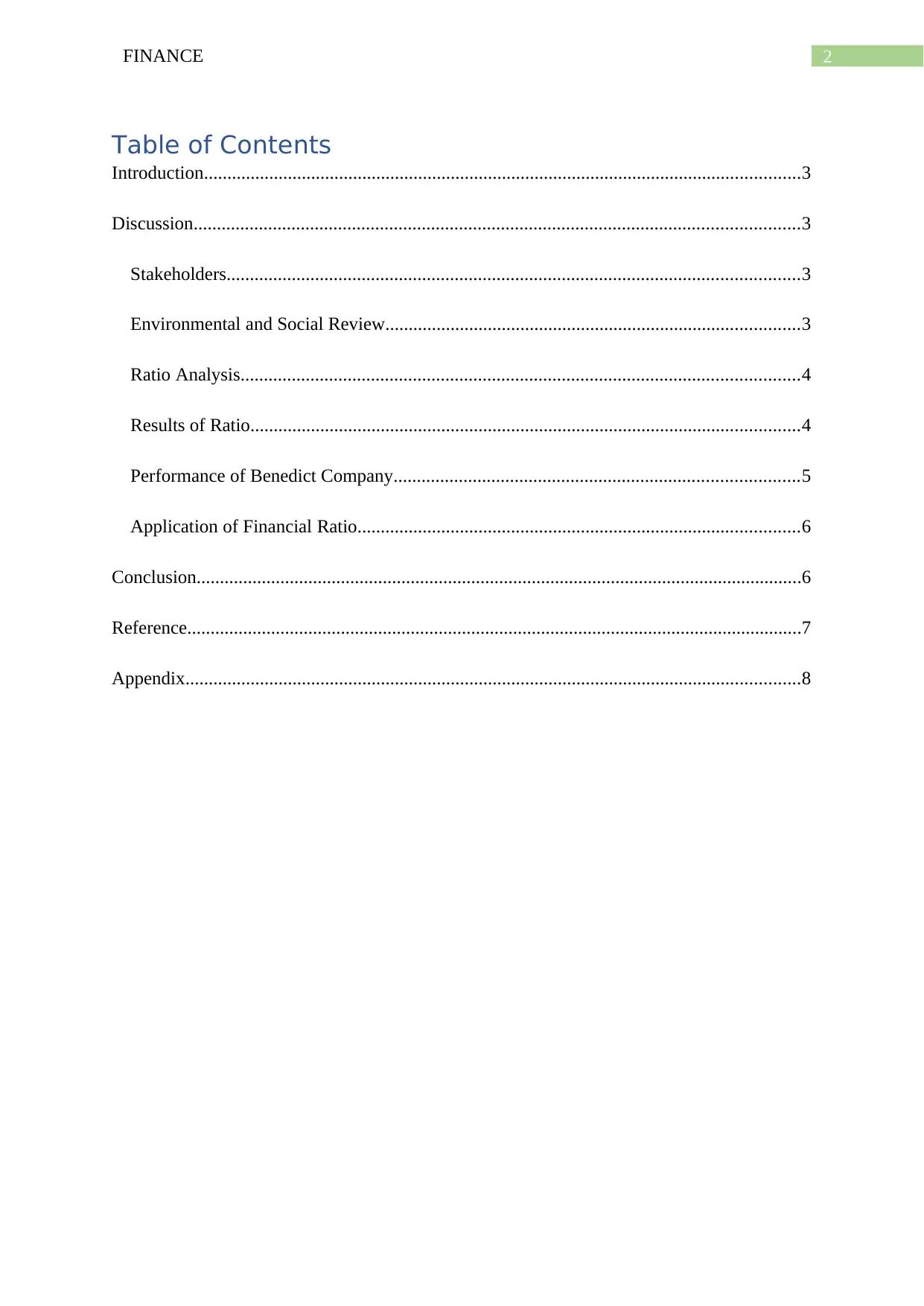
2FINANCE
Table of Contents
Introduction................................................................................................................................3
Discussion..................................................................................................................................3
Stakeholders...........................................................................................................................3
Environmental and Social Review.........................................................................................3
Ratio Analysis........................................................................................................................4
Results of Ratio......................................................................................................................4
Performance of Benedict Company.......................................................................................5
Application of Financial Ratio...............................................................................................6
Conclusion..................................................................................................................................6
Reference....................................................................................................................................7
Appendix....................................................................................................................................8
Table of Contents
Introduction................................................................................................................................3
Discussion..................................................................................................................................3
Stakeholders...........................................................................................................................3
Environmental and Social Review.........................................................................................3
Ratio Analysis........................................................................................................................4
Results of Ratio......................................................................................................................4
Performance of Benedict Company.......................................................................................5
Application of Financial Ratio...............................................................................................6
Conclusion..................................................................................................................................6
Reference....................................................................................................................................7
Appendix....................................................................................................................................8
⊘ This is a preview!⊘
Do you want full access?
Subscribe today to unlock all pages.

Trusted by 1+ million students worldwide
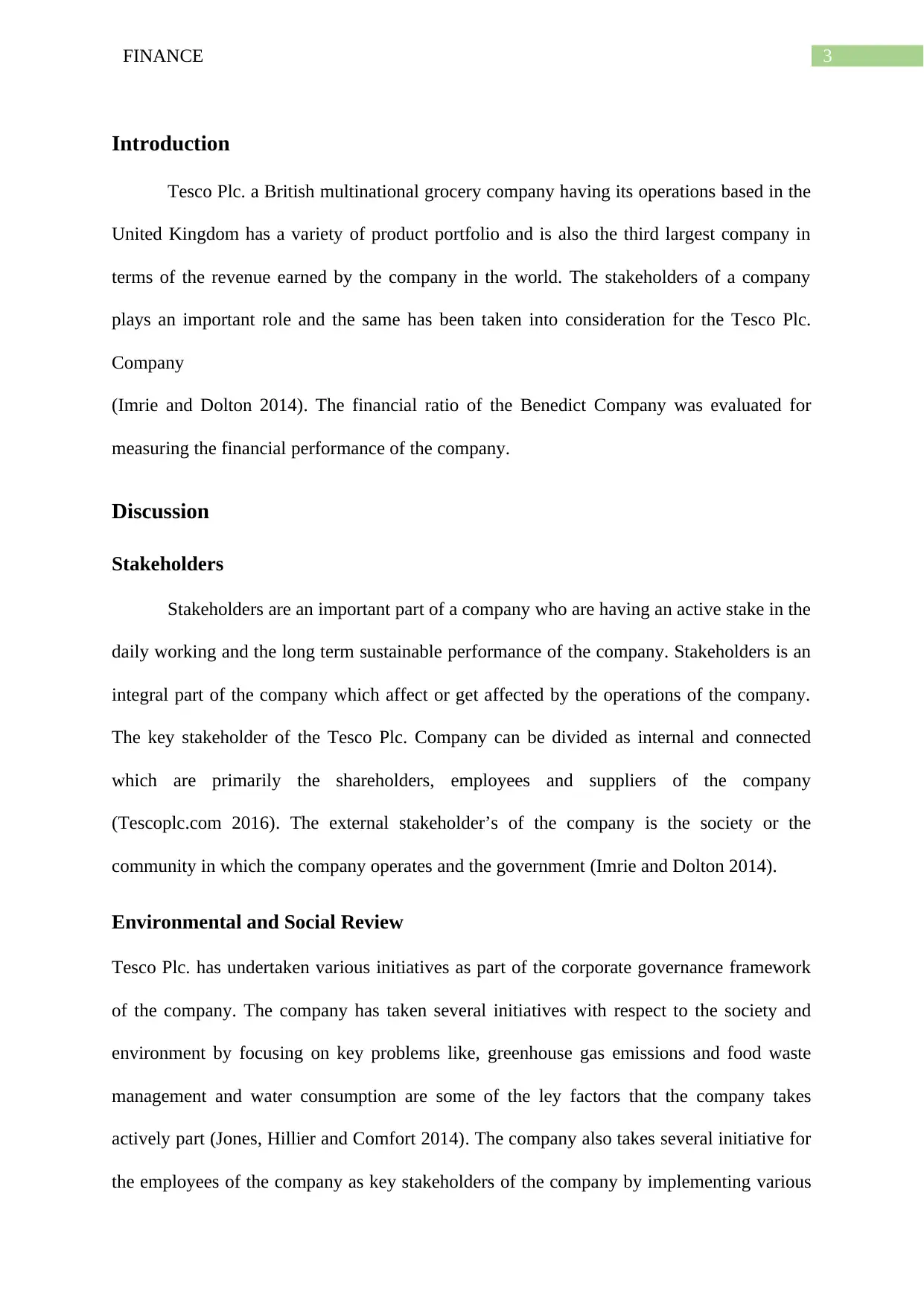
3FINANCE
Introduction
Tesco Plc. a British multinational grocery company having its operations based in the
United Kingdom has a variety of product portfolio and is also the third largest company in
terms of the revenue earned by the company in the world. The stakeholders of a company
plays an important role and the same has been taken into consideration for the Tesco Plc.
Company
(Imrie and Dolton 2014). The financial ratio of the Benedict Company was evaluated for
measuring the financial performance of the company.
Discussion
Stakeholders
Stakeholders are an important part of a company who are having an active stake in the
daily working and the long term sustainable performance of the company. Stakeholders is an
integral part of the company which affect or get affected by the operations of the company.
The key stakeholder of the Tesco Plc. Company can be divided as internal and connected
which are primarily the shareholders, employees and suppliers of the company
(Tescoplc.com 2016). The external stakeholder’s of the company is the society or the
community in which the company operates and the government (Imrie and Dolton 2014).
Environmental and Social Review
Tesco Plc. has undertaken various initiatives as part of the corporate governance framework
of the company. The company has taken several initiatives with respect to the society and
environment by focusing on key problems like, greenhouse gas emissions and food waste
management and water consumption are some of the ley factors that the company takes
actively part (Jones, Hillier and Comfort 2014). The company also takes several initiative for
the employees of the company as key stakeholders of the company by implementing various
Introduction
Tesco Plc. a British multinational grocery company having its operations based in the
United Kingdom has a variety of product portfolio and is also the third largest company in
terms of the revenue earned by the company in the world. The stakeholders of a company
plays an important role and the same has been taken into consideration for the Tesco Plc.
Company
(Imrie and Dolton 2014). The financial ratio of the Benedict Company was evaluated for
measuring the financial performance of the company.
Discussion
Stakeholders
Stakeholders are an important part of a company who are having an active stake in the
daily working and the long term sustainable performance of the company. Stakeholders is an
integral part of the company which affect or get affected by the operations of the company.
The key stakeholder of the Tesco Plc. Company can be divided as internal and connected
which are primarily the shareholders, employees and suppliers of the company
(Tescoplc.com 2016). The external stakeholder’s of the company is the society or the
community in which the company operates and the government (Imrie and Dolton 2014).
Environmental and Social Review
Tesco Plc. has undertaken various initiatives as part of the corporate governance framework
of the company. The company has taken several initiatives with respect to the society and
environment by focusing on key problems like, greenhouse gas emissions and food waste
management and water consumption are some of the ley factors that the company takes
actively part (Jones, Hillier and Comfort 2014). The company also takes several initiative for
the employees of the company as key stakeholders of the company by implementing various
Paraphrase This Document
Need a fresh take? Get an instant paraphrase of this document with our AI Paraphraser
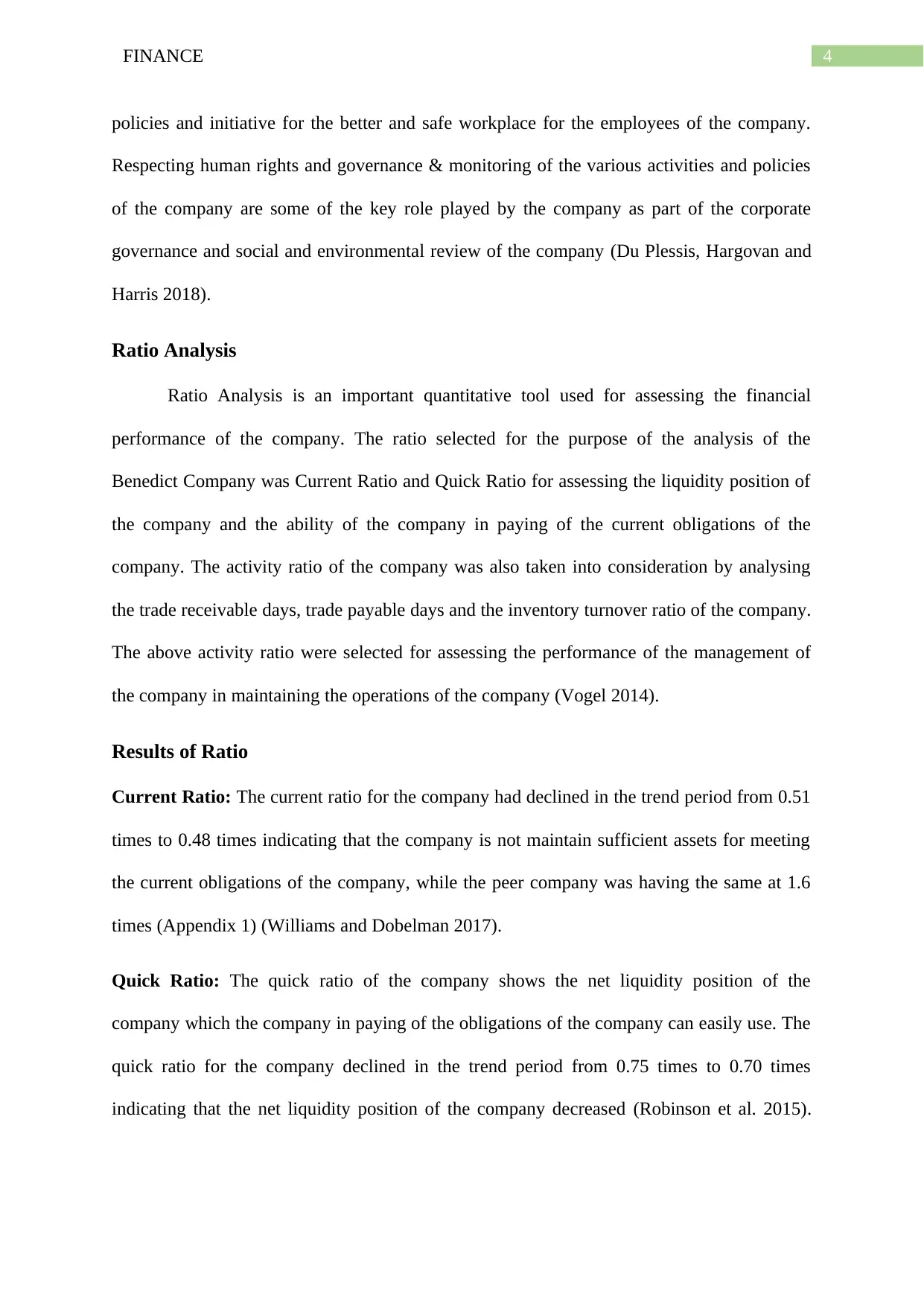
4FINANCE
policies and initiative for the better and safe workplace for the employees of the company.
Respecting human rights and governance & monitoring of the various activities and policies
of the company are some of the key role played by the company as part of the corporate
governance and social and environmental review of the company (Du Plessis, Hargovan and
Harris 2018).
Ratio Analysis
Ratio Analysis is an important quantitative tool used for assessing the financial
performance of the company. The ratio selected for the purpose of the analysis of the
Benedict Company was Current Ratio and Quick Ratio for assessing the liquidity position of
the company and the ability of the company in paying of the current obligations of the
company. The activity ratio of the company was also taken into consideration by analysing
the trade receivable days, trade payable days and the inventory turnover ratio of the company.
The above activity ratio were selected for assessing the performance of the management of
the company in maintaining the operations of the company (Vogel 2014).
Results of Ratio
Current Ratio: The current ratio for the company had declined in the trend period from 0.51
times to 0.48 times indicating that the company is not maintain sufficient assets for meeting
the current obligations of the company, while the peer company was having the same at 1.6
times (Appendix 1) (Williams and Dobelman 2017).
Quick Ratio: The quick ratio of the company shows the net liquidity position of the
company which the company in paying of the obligations of the company can easily use. The
quick ratio for the company declined in the trend period from 0.75 times to 0.70 times
indicating that the net liquidity position of the company decreased (Robinson et al. 2015).
policies and initiative for the better and safe workplace for the employees of the company.
Respecting human rights and governance & monitoring of the various activities and policies
of the company are some of the key role played by the company as part of the corporate
governance and social and environmental review of the company (Du Plessis, Hargovan and
Harris 2018).
Ratio Analysis
Ratio Analysis is an important quantitative tool used for assessing the financial
performance of the company. The ratio selected for the purpose of the analysis of the
Benedict Company was Current Ratio and Quick Ratio for assessing the liquidity position of
the company and the ability of the company in paying of the current obligations of the
company. The activity ratio of the company was also taken into consideration by analysing
the trade receivable days, trade payable days and the inventory turnover ratio of the company.
The above activity ratio were selected for assessing the performance of the management of
the company in maintaining the operations of the company (Vogel 2014).
Results of Ratio
Current Ratio: The current ratio for the company had declined in the trend period from 0.51
times to 0.48 times indicating that the company is not maintain sufficient assets for meeting
the current obligations of the company, while the peer company was having the same at 1.6
times (Appendix 1) (Williams and Dobelman 2017).
Quick Ratio: The quick ratio of the company shows the net liquidity position of the
company which the company in paying of the obligations of the company can easily use. The
quick ratio for the company declined in the trend period from 0.75 times to 0.70 times
indicating that the net liquidity position of the company decreased (Robinson et al. 2015).
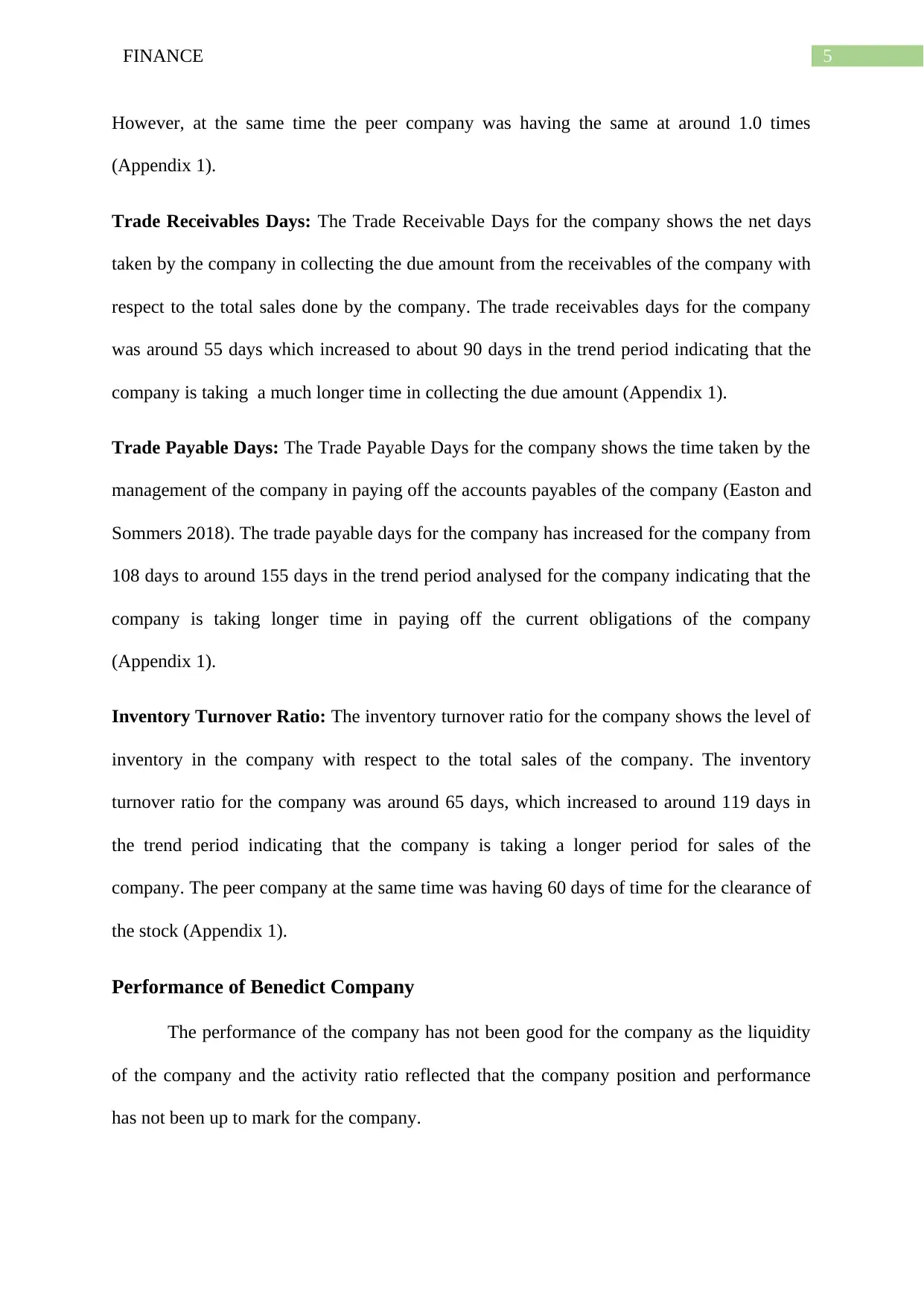
5FINANCE
However, at the same time the peer company was having the same at around 1.0 times
(Appendix 1).
Trade Receivables Days: The Trade Receivable Days for the company shows the net days
taken by the company in collecting the due amount from the receivables of the company with
respect to the total sales done by the company. The trade receivables days for the company
was around 55 days which increased to about 90 days in the trend period indicating that the
company is taking a much longer time in collecting the due amount (Appendix 1).
Trade Payable Days: The Trade Payable Days for the company shows the time taken by the
management of the company in paying off the accounts payables of the company (Easton and
Sommers 2018). The trade payable days for the company has increased for the company from
108 days to around 155 days in the trend period analysed for the company indicating that the
company is taking longer time in paying off the current obligations of the company
(Appendix 1).
Inventory Turnover Ratio: The inventory turnover ratio for the company shows the level of
inventory in the company with respect to the total sales of the company. The inventory
turnover ratio for the company was around 65 days, which increased to around 119 days in
the trend period indicating that the company is taking a longer period for sales of the
company. The peer company at the same time was having 60 days of time for the clearance of
the stock (Appendix 1).
Performance of Benedict Company
The performance of the company has not been good for the company as the liquidity
of the company and the activity ratio reflected that the company position and performance
has not been up to mark for the company.
However, at the same time the peer company was having the same at around 1.0 times
(Appendix 1).
Trade Receivables Days: The Trade Receivable Days for the company shows the net days
taken by the company in collecting the due amount from the receivables of the company with
respect to the total sales done by the company. The trade receivables days for the company
was around 55 days which increased to about 90 days in the trend period indicating that the
company is taking a much longer time in collecting the due amount (Appendix 1).
Trade Payable Days: The Trade Payable Days for the company shows the time taken by the
management of the company in paying off the accounts payables of the company (Easton and
Sommers 2018). The trade payable days for the company has increased for the company from
108 days to around 155 days in the trend period analysed for the company indicating that the
company is taking longer time in paying off the current obligations of the company
(Appendix 1).
Inventory Turnover Ratio: The inventory turnover ratio for the company shows the level of
inventory in the company with respect to the total sales of the company. The inventory
turnover ratio for the company was around 65 days, which increased to around 119 days in
the trend period indicating that the company is taking a longer period for sales of the
company. The peer company at the same time was having 60 days of time for the clearance of
the stock (Appendix 1).
Performance of Benedict Company
The performance of the company has not been good for the company as the liquidity
of the company and the activity ratio reflected that the company position and performance
has not been up to mark for the company.
⊘ This is a preview!⊘
Do you want full access?
Subscribe today to unlock all pages.

Trusted by 1+ million students worldwide
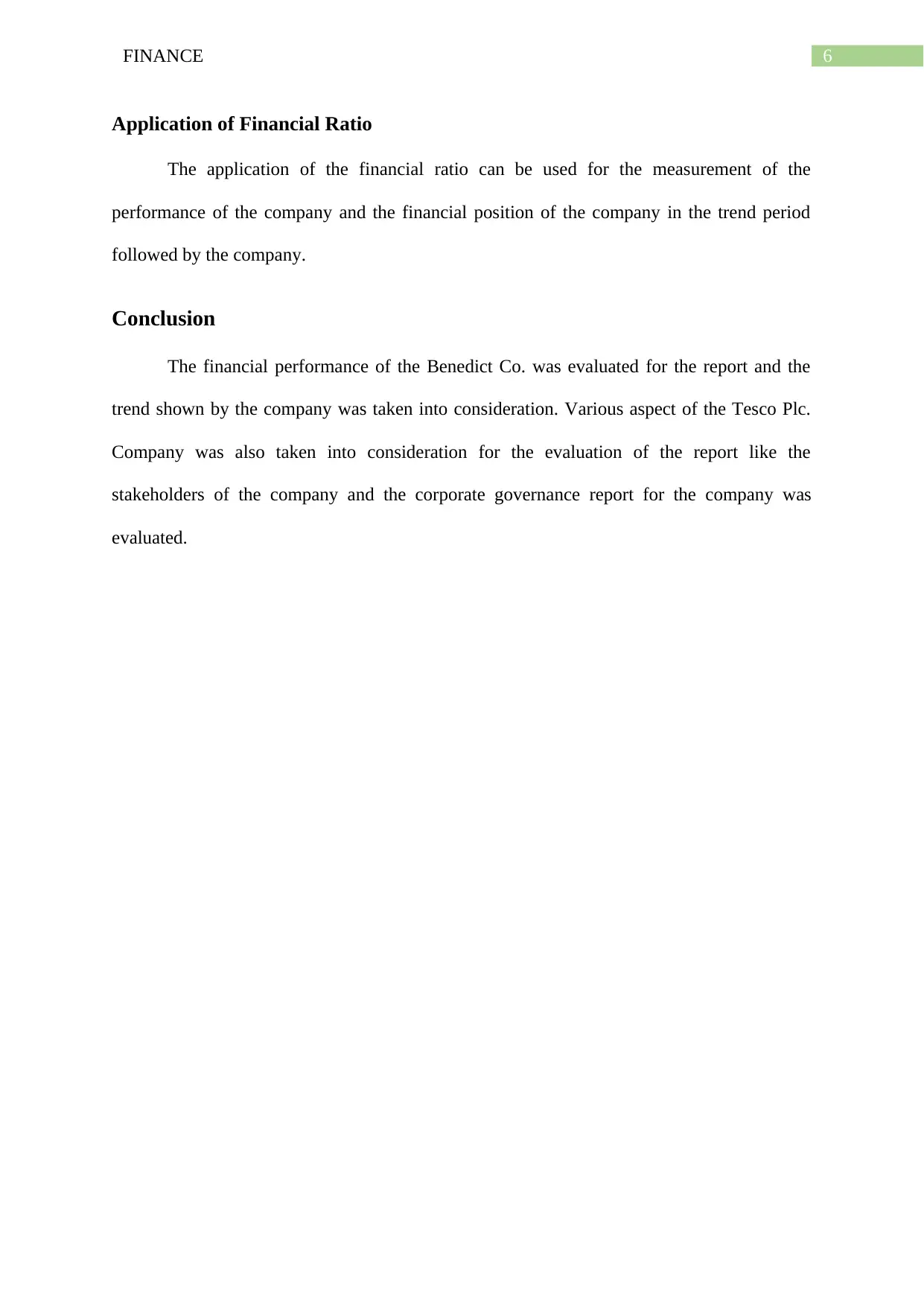
6FINANCE
Application of Financial Ratio
The application of the financial ratio can be used for the measurement of the
performance of the company and the financial position of the company in the trend period
followed by the company.
Conclusion
The financial performance of the Benedict Co. was evaluated for the report and the
trend shown by the company was taken into consideration. Various aspect of the Tesco Plc.
Company was also taken into consideration for the evaluation of the report like the
stakeholders of the company and the corporate governance report for the company was
evaluated.
Application of Financial Ratio
The application of the financial ratio can be used for the measurement of the
performance of the company and the financial position of the company in the trend period
followed by the company.
Conclusion
The financial performance of the Benedict Co. was evaluated for the report and the
trend shown by the company was taken into consideration. Various aspect of the Tesco Plc.
Company was also taken into consideration for the evaluation of the report like the
stakeholders of the company and the corporate governance report for the company was
evaluated.
Paraphrase This Document
Need a fresh take? Get an instant paraphrase of this document with our AI Paraphraser
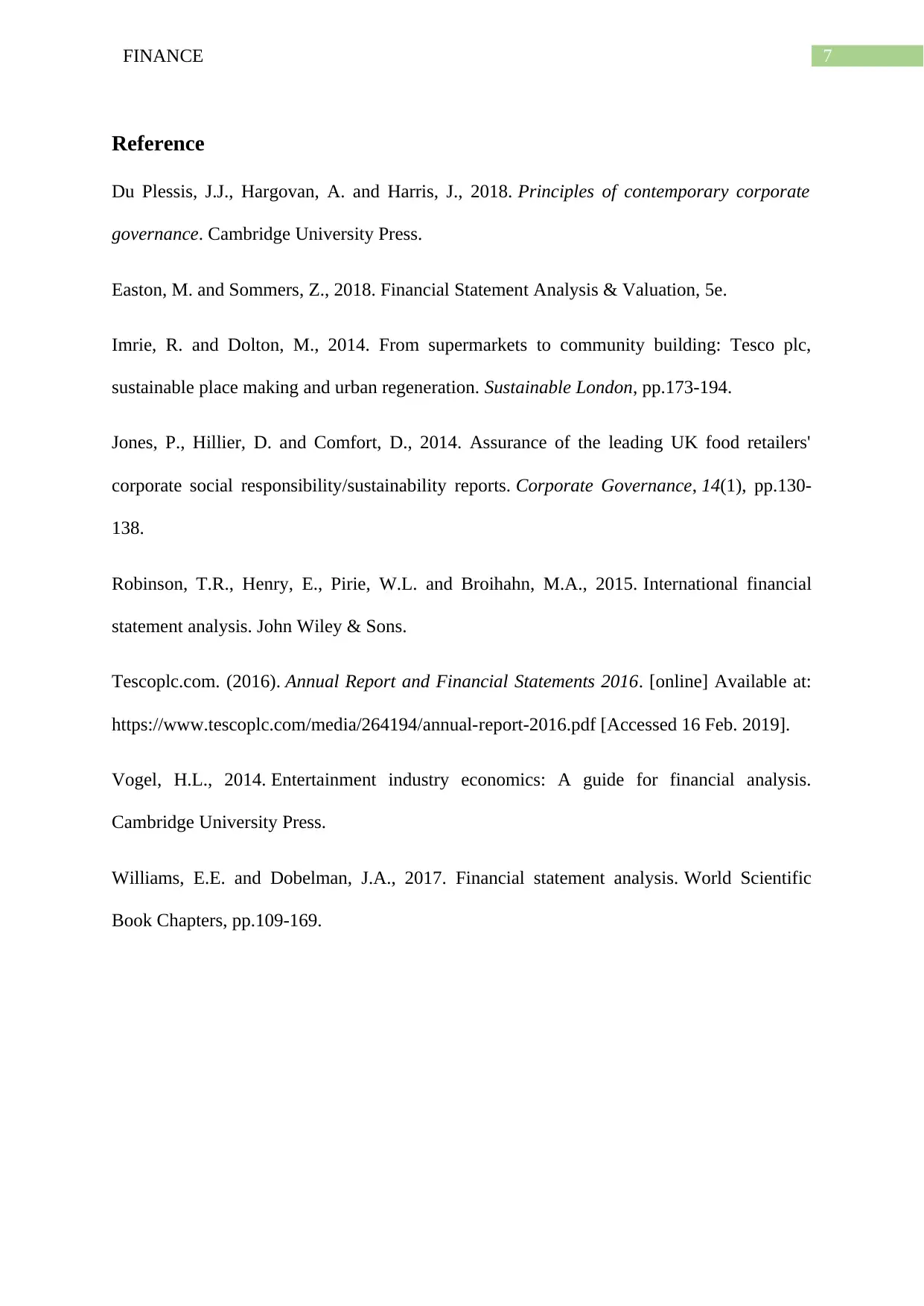
7FINANCE
Reference
Du Plessis, J.J., Hargovan, A. and Harris, J., 2018. Principles of contemporary corporate
governance. Cambridge University Press.
Easton, M. and Sommers, Z., 2018. Financial Statement Analysis & Valuation, 5e.
Imrie, R. and Dolton, M., 2014. From supermarkets to community building: Tesco plc,
sustainable place making and urban regeneration. Sustainable London, pp.173-194.
Jones, P., Hillier, D. and Comfort, D., 2014. Assurance of the leading UK food retailers'
corporate social responsibility/sustainability reports. Corporate Governance, 14(1), pp.130-
138.
Robinson, T.R., Henry, E., Pirie, W.L. and Broihahn, M.A., 2015. International financial
statement analysis. John Wiley & Sons.
Tescoplc.com. (2016). Annual Report and Financial Statements 2016. [online] Available at:
https://www.tescoplc.com/media/264194/annual-report-2016.pdf [Accessed 16 Feb. 2019].
Vogel, H.L., 2014. Entertainment industry economics: A guide for financial analysis.
Cambridge University Press.
Williams, E.E. and Dobelman, J.A., 2017. Financial statement analysis. World Scientific
Book Chapters, pp.109-169.
Reference
Du Plessis, J.J., Hargovan, A. and Harris, J., 2018. Principles of contemporary corporate
governance. Cambridge University Press.
Easton, M. and Sommers, Z., 2018. Financial Statement Analysis & Valuation, 5e.
Imrie, R. and Dolton, M., 2014. From supermarkets to community building: Tesco plc,
sustainable place making and urban regeneration. Sustainable London, pp.173-194.
Jones, P., Hillier, D. and Comfort, D., 2014. Assurance of the leading UK food retailers'
corporate social responsibility/sustainability reports. Corporate Governance, 14(1), pp.130-
138.
Robinson, T.R., Henry, E., Pirie, W.L. and Broihahn, M.A., 2015. International financial
statement analysis. John Wiley & Sons.
Tescoplc.com. (2016). Annual Report and Financial Statements 2016. [online] Available at:
https://www.tescoplc.com/media/264194/annual-report-2016.pdf [Accessed 16 Feb. 2019].
Vogel, H.L., 2014. Entertainment industry economics: A guide for financial analysis.
Cambridge University Press.
Williams, E.E. and Dobelman, J.A., 2017. Financial statement analysis. World Scientific
Book Chapters, pp.109-169.
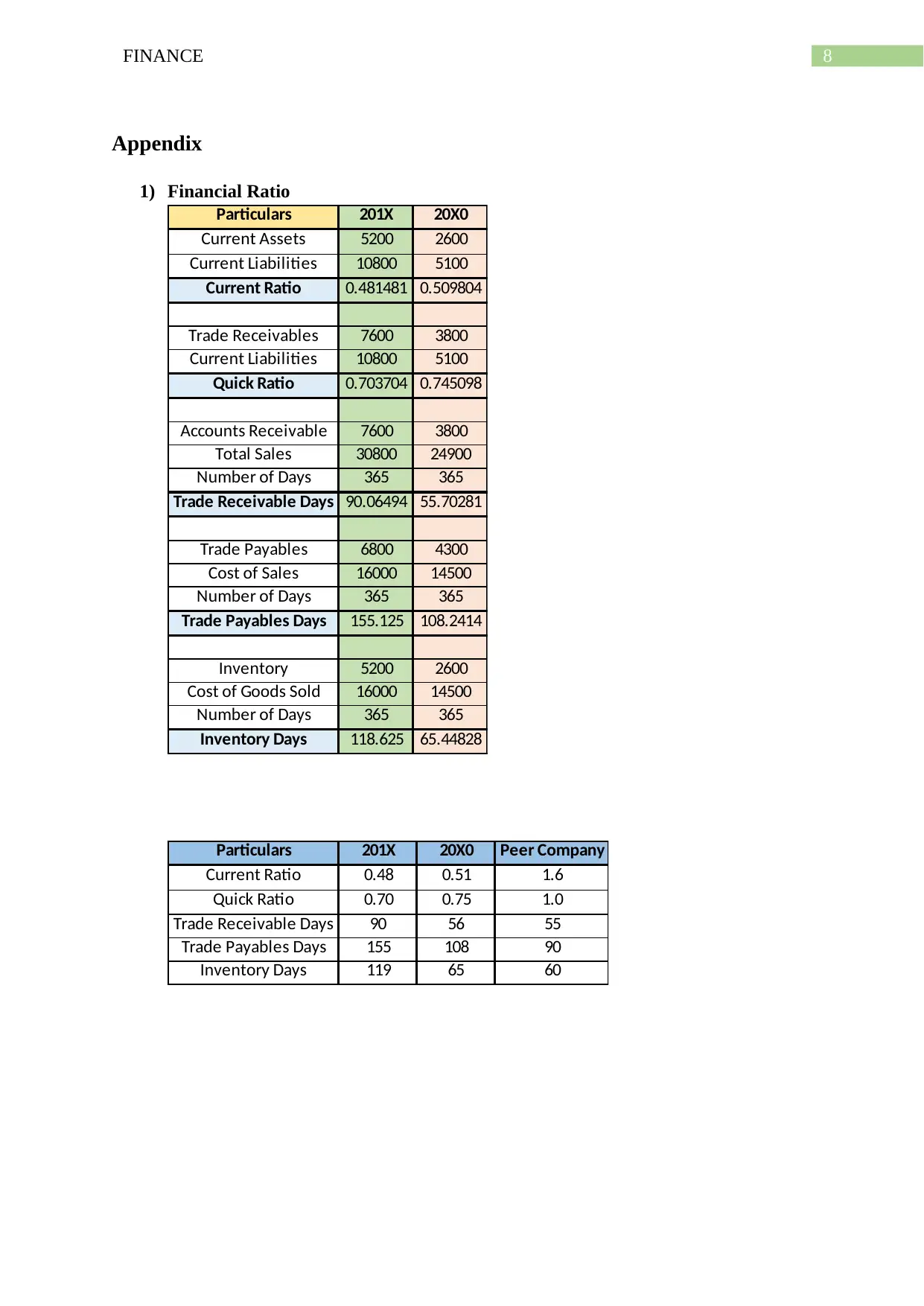
8FINANCE
Appendix
1) Financial Ratio
Particulars 201X 20X0 Peer Company
Current Ratio 0.48 0.51 1.6
Quick Ratio 0.70 0.75 1.0
Trade Receivable Days 90 56 55
Trade Payables Days 155 108 90
Inventory Days 119 65 60
Particulars 201X 20X0
Current Assets 5200 2600
Current Liabilities 10800 5100
Current Ratio 0.481481 0.509804
Trade Receivables 7600 3800
Current Liabilities 10800 5100
Quick Ratio 0.703704 0.745098
Accounts Receivable 7600 3800
Total Sales 30800 24900
Number of Days 365 365
Trade Receivable Days 90.06494 55.70281
Trade Payables 6800 4300
Cost of Sales 16000 14500
Number of Days 365 365
Trade Payables Days 155.125 108.2414
Inventory 5200 2600
Cost of Goods Sold 16000 14500
Number of Days 365 365
Inventory Days 118.625 65.44828
Appendix
1) Financial Ratio
Particulars 201X 20X0 Peer Company
Current Ratio 0.48 0.51 1.6
Quick Ratio 0.70 0.75 1.0
Trade Receivable Days 90 56 55
Trade Payables Days 155 108 90
Inventory Days 119 65 60
Particulars 201X 20X0
Current Assets 5200 2600
Current Liabilities 10800 5100
Current Ratio 0.481481 0.509804
Trade Receivables 7600 3800
Current Liabilities 10800 5100
Quick Ratio 0.703704 0.745098
Accounts Receivable 7600 3800
Total Sales 30800 24900
Number of Days 365 365
Trade Receivable Days 90.06494 55.70281
Trade Payables 6800 4300
Cost of Sales 16000 14500
Number of Days 365 365
Trade Payables Days 155.125 108.2414
Inventory 5200 2600
Cost of Goods Sold 16000 14500
Number of Days 365 365
Inventory Days 118.625 65.44828
⊘ This is a preview!⊘
Do you want full access?
Subscribe today to unlock all pages.

Trusted by 1+ million students worldwide
1 out of 9
Related Documents
Your All-in-One AI-Powered Toolkit for Academic Success.
+13062052269
info@desklib.com
Available 24*7 on WhatsApp / Email
![[object Object]](/_next/static/media/star-bottom.7253800d.svg)
Unlock your academic potential
Copyright © 2020–2025 A2Z Services. All Rights Reserved. Developed and managed by ZUCOL.





